Grip it and Rip it!
Get your grind on with the new era of handheld grinders as we appreciate how far this gadget has come in recent years.
Words by Melanie Winter
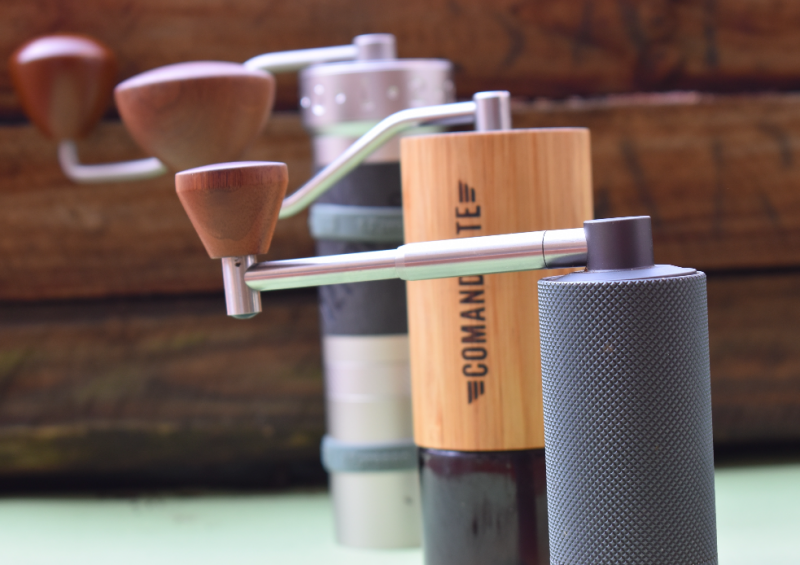
If you’re looking for a little bit of an upper arm workout, particularly the triceps I find, during your morning coffee routine, then look no further than getting yourself a hand grinder. But jokes aside, the real reason for acquiring one of these gadgets, apart from being able to take your coffee routine with you on the road, is that it is no understatement to say that a good grinder can completely change your coffee drinking life and help you achieve a small, but significant brewing success every day.
While the hand grinder may have in the past been seen as a cheaper alternative to an electric grinder and stayed mostly in place as a travel option for peak coffee enthusiasts, the really good ones are now considered indispensable to any home coffee set up and they’re (mostly) still cheaper than the electric kind. They have definitely become somewhat of a badge of honour, with coffee professionals always admiring and comparing the different options.
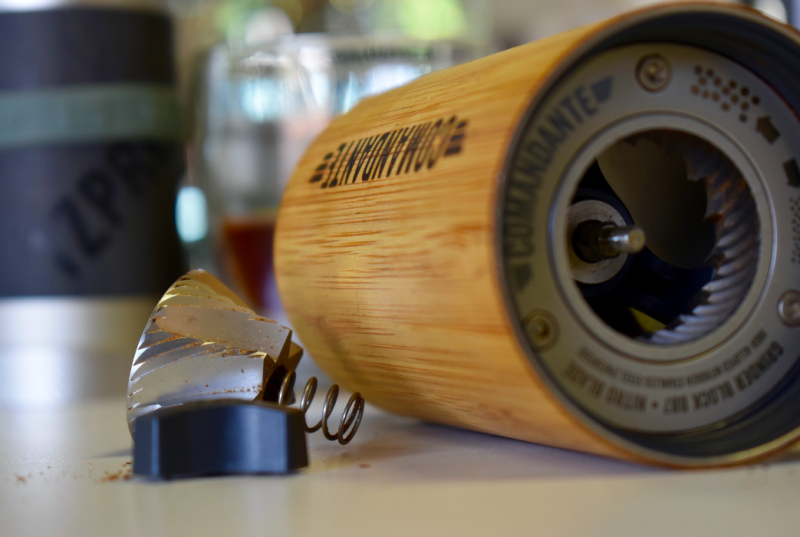
Conical burrs (specifically a specially designed hexagonal shape) of the COMANDANTE
The mechanism is a pretty simple crank system. The hand crank is connected by an axle to a shaft which in turn moves a burr against another burr. You can adjust how far apart the burrs sit to determine the grind size of your coffee. But the details of hand grinders have come a long way in the last 10 years. The best have the capability to consistently make fantastic coffee for all styles of brewing from filter to espressos.
One of the biggest updates to the humble hand grinder was the advent of the axle being fixed on ball bearings, dual to be precise (which grinder manufacturers are partial to being). While most hand grinders require a bit of force and effort to get the handle to turn at all, the dual ball bearing cranks are able to spin freely in a circle multiple times just with a light push. The ball bearings also means there is no rocking between the crank parts which means consistency. Remember I mentioned you might get a work out, well, In fact, if they’re doing there jobs right, these little guys mean that when coffee starts to add resistance to the cranks, it’s easy to build momentum and power through even the densest, light-roasted single origin coffees without breaking a sweat.
Let’s touch on that for a second. Why do light roasts take more effort to grind? Well that all comes down to density. The longer a coffee is roasted, the less dense it becomes as the moisture is literally roasted out of it. Some specialty varietals are also naturally more dense, such as Bourbon or very high altitude grown cherries, that develop slower due to the temperatures and result in a more dense bean. But I digress. Back to hand grinders!
For a long time, and in lots of very competent and very affordable grinders on the market today, the most popular material for these burrs was ceramic. Ceramic is especially long-lasting, but recently the top grinders on the market use stainless steel for their burrs, following the lead of their commercial and electric counterparts, with any number of coatings or enhancements to assist in achieving the long-lasting record of the ceramic alternatives. The chief reason for a shift to stainless steel is precision. The ceramic version is never going to be as sharp as the definition found in stainless steel and control over the grind particles is what the nerds (like me) are into.
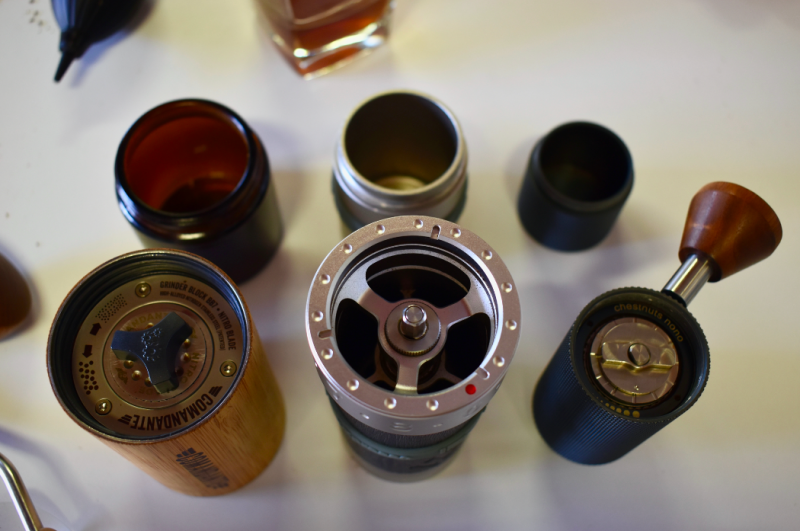
Size has also come to matter, not in capacity specifically, but in the diameter of the burrs, which means speed! The wider the burrs, the more beans pass through them with each crank of the grinder.
We’ve picked three of our favourite options in the premium hand grinder category that we know you’d love and would make a difference to your coffee experience. The long and short of it, is that any of these options offer amazing consistency in particle size, variability from Turkish to coarse grind and a wonderful user experience. You really can’t go wrong with any of these options, there are just a few quirks that set them apart from each other.
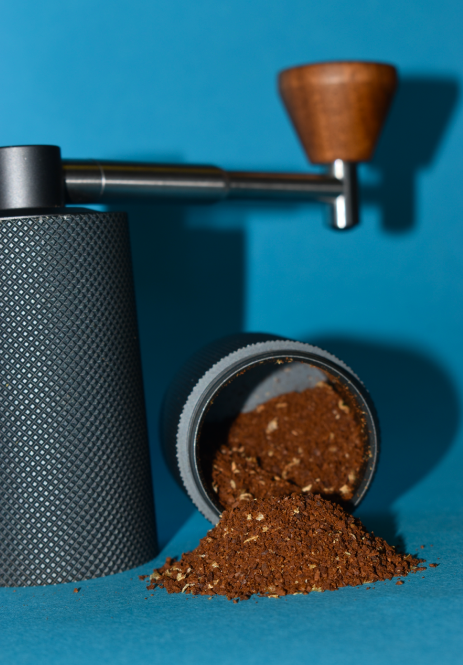
Timemore Chestnut Nano
As with anything that the Timemore brand touches, the Chestnut looks pretty damn good, and it also feels good. The slim barrel is comfortable and, speaking on behalf of people everywhere with smaller than average hands, even I can really get my hands around it. It also has a unique textured surface that makes the grinder easier to hold. This is a nice touch if you’re grinding light roasts and don’t have the grip strength of a seasoned rock climber. Or you’re in the middle of a Durban summer. The classy aluminium alloy body is also quite a statement and fairly indestructible.
The Nano that we have had for a number of years, is the baby of the Chestnut Range. The major differences being capacity (15g v 20-30g) and the fold away handle that makes the Nano very travel friendly (all the hand grinders you have to remove the lid and handle before you pack them away). This fact also means that you can pre-load your chamber with beans before a hike, for example. It comes with 38mm burrs. But even the C3 Pro, the upgraded Chestnut, loved the foldable handle so much, it now comes as a standard feature.
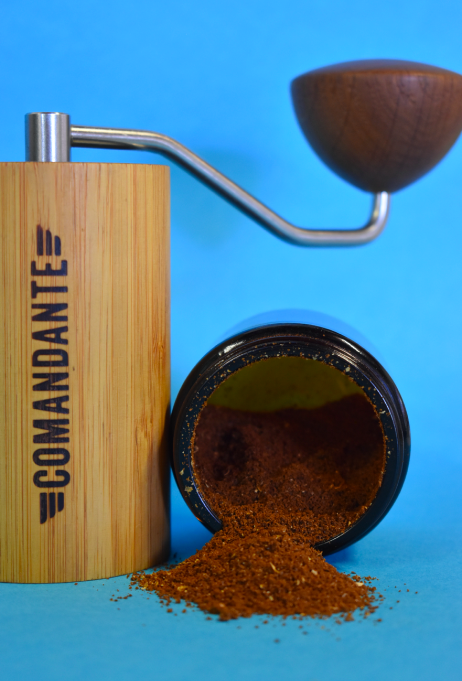
COMANDANTE® C40
We had the pleasure of meeting Bernd Braune, the founder and one of the designers of the COMANDANTE® in 2018 at the very end of the London Coffee Festival and I nabbed the demo unit (it was the only thing they had left to sell!). But the thing that stood out the most for me, was that at the end of a very busy week of talking about nothing but grinders, the passion for talking about it was not even a little bit diminished. He was only too happy to repeat his journey as a coffee roasting family and the need for a good hand grinder on sourcing trips that started the journey to this now world renowned handheld grinder!
The C40 has become iconic and pretty much synonymous with the hand grinder sector. It looks beautiful and you’re definitely buying into a movement and a brand and it’s a pretty cool movement to be a part of.
Some have argued that they don’t recommend it for espresso, but we have successfully used it to pull delicious shots, it does just take quite a long time to get the job done. The purists say the standard stepped grind adjustments (the clicks), are a bit too large, making it difficult to dial in as you would on a commercial grade piece of equipment. But there is additional piece of equipment that has recently been introduced for said purists (we have not tested this) called Redclix, which increases the grind clicks from 12 to 24 per rotation, allowing for more precise dialing-in.
The grinds chamber on the C40 is generally made out of glass; however, I’ve heard rumours of the new shatter-proof polymer version that has been introduced. This is good, as I have lost a chamber to clumsiness, luckily the grinder comes with two in the first place.
Hot Tip: The clicks start from when the burrs are closest together so if you ever see Comandante Grind Setting 16, this means you start from as tight as the burrs can go and click 16 times.
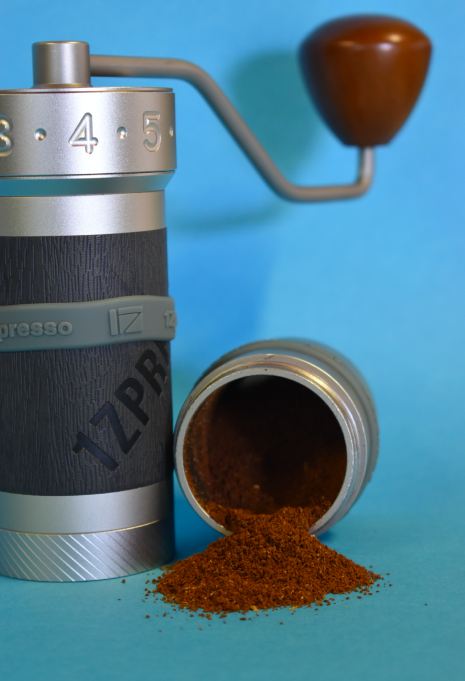
1Zpresso is a Taiwanese hand grinder brand that is producing some really high quality products at a very affordable price-points. Now, we puzzled over the name, but it all makes perfect sense when you know that the number 1 is pronounced ‘eee’ meaning that phonetically you pronounce it as ‘eee’Zpresso (easypresso!). The name is also a nod to the fact that they intend their grinders to be used for espressos.
Our favourite part of their design is that you can adjust the grind from the top and the dial 1(most fine) to 10 (most coarse) makes it easy to repeat your selected grind setting, even in between cups if you happen to be making two different brew methods. This is a convenience most other hand grinders haven’t got. In our tests, you can get and amazing espresso shot from 2.5 and great pour over results with anything from 5.5 to 6.5. Each click adjusts the burr set just 12.5 microns, allowing extremely precise control over the grind setting to really nail down your espresso recipe.
But in our opinion, the main advantage of the 1Zpresso range is the wide 48mm burrs which means you have a super-speedy grinding experience. No more breaking a sweat for this hand grinder user!